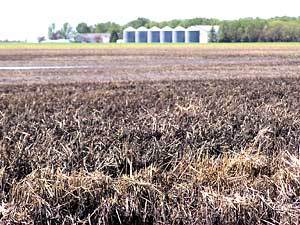|
Audio
Photos
Resources
|
July 15, 2005
 |
| This wheat field was flooded and then pounded by hail, destroying the crop. (MPR Photo/Dan Gunderson) |
Hallock, Minn. — The sour smell of rotting crops fills the air around Hallock, Minnesota. Some crops are bleached white, while others are blackened from standing in water.
In the past two months, as much as 27 inches of rain has fallen on parts of Kittson County.
"Since the Mothers Day weekend we've only been in the field probably parts of four or five days," says farmer Ken Wiese.
Since he started farming in the 1940s, Ken Wiese has never seen such a long stretch of bad weather. There's only been two good crop years here since 1993, and most years it's been too wet.
Ken Wiese farms with sons Neil and Mark, who are starting to wonder why they came back to the farm.
"A lot of people would either like to rewind to start over, or fast forward to another year, because it just wears on you," says Mark Wiese.
"It does get to the point where you get tired and you ask yourself, maybe something unrelated to the weather would be more appealing," laughs Neil Wiese.
The Wiese family farms 3,000 acres of mostly wheat, soybeans and sugar beets in Kittson County. They expect to lose money on all the crops this year.
Like most farmers, they have crop insurance. Congress set up the crop insurance program to take the place of ad hoc disaster legislation every time there's a crop disaster, but Neil Wiese says crop insurance doesn't cover a lost crop.
He explains that crop insurance will pay $120 an acre for a destroyed wheat crop, but it costs $150 an acre to plant that wheat.
"It's not a moneymaker, it's not even a break-even. It helps minimize some of your losses, but they're still there. And when you have them year after year -- you just can't keep going year after year like that," says Wiese.
Neil Wiese and his wife both have off-farm jobs to help pay their living expenses. But like most farmers around here, they're spending less money, and that's cutting into the profits for local business owners.
Most crop farmers are already looking ahead to next year. But cattle producers are worried about making it through the winter, because wet fields may have them scrambling to find enough hay to feed their cows. Wet conditions have destroyed much of the early summer hay crop, according to Howard Person, the ag extension agent for Marshall and Pennington counties.
"There's a hay producer right north of me, and I could have taken a canoe across his hayfield, there was that much water. The first cutting of hay was lying in swaths floating in the field. That hay is shot," says Person.
Some counties are asking the U.S. Department of Agriculture to allow farmers to put up hay on conservation reserve land, and some counties have already gotten permission to graze cattle on CRP land.
Several Minnesota counties may qualify for federal disaster status, but a federal disaster declaration may be of little help to farmers in northwest Minnesota.
Disaster status makes farmers eligible for low interest loans, but ag extension agent Howard Person says that's not what farmers need.
"Farmers have learned that from the past. You aren't going to borrow your way out of debt. More loans on top of loans just doesn't help," says Person. "There's not much enthusiasm for a disaster declaration unless we can get Congress to put some extra dollars in for disaster payments, as they did last year."
The only reason Minnesota farmers got disaster aid in 2004 was because of an active hurricane season. Extensive damage in southern states prompted a federal disaster bill, and farmers across the country were included. No one wants to say it, but Minnesota farmers know their best hope for disaster aid is another bad hurricane season.






